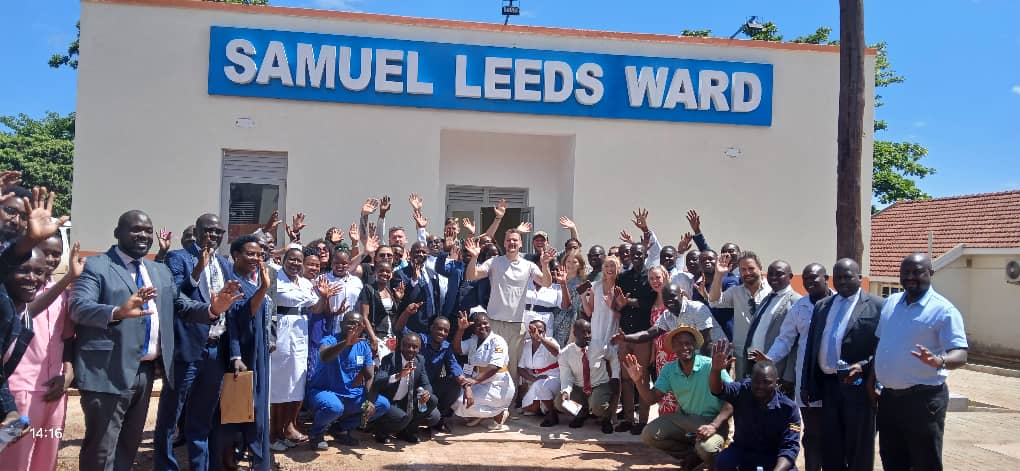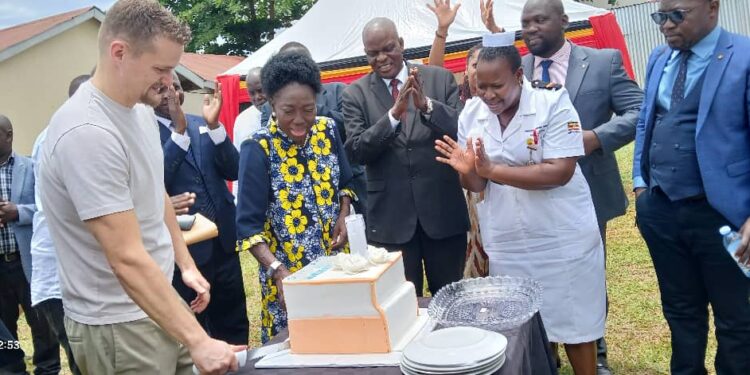The First Deputy Prime Minister and Minister in charge of East African Community Affairs, Rt. Hon. Rebecca Alitwala Kadaga has urged the government to ensure equity in its planning and distribution of services across the country.
Speaking as the guest of honor during the commissioning of the Samuel Leeds Orthopedic Ward and the new Oxygen Plant at the Jinja Regional Referral Hospital on Tuesday, Kadaga expressed concern over the concentration of specialized health facilities in the capital, Kampala.
“…all the best and specialized health facilities like Kirudu, Kawempe, Naguru, and Mulago, among others, are in Kampala, leaving regions like Busoga with basically nothing,..” Kadaga noted.
Known for her unwavering advocacy and lobbying, the Kamuli District Woman MP emphasized that the situation was acceptable when Uganda’s population was only 8 million, but with the current population standing at 45 million, according to the 2024 census, there is a need for more inclusive planning.
“…how will someone from Karamoja benefit from these services…?” Kadaga asked, challenging the Ministry of Health to develop new strategic plans to upgrade the Jinja Regional Referral Hospital.
Most of the hospital’s buildings were constructed in the 1930s; primarily to treat soldiers returning from World War I.
Rt Hon Kadaga tasked the head of infrastructure in the Ministry of Health to give the hospital a new face.
Anyone visiting for the first time will notice the worn-out facility,which stands as a testament to time’s relentless passage, its once-vibrant exterior now faded and weathered.
The corrugated iron roof, renovated multiple times, is rusted to a deep orange, and seems to sag under the weight of years, while the once-solid foundations now show signs of strain, cracks spreading like a spider’s web.

The Director Curative Services in the Ministry of Health Dr Charles Olaro who represented the Minister of Health Dr Jane Aceng Ocero promised to forward Kadaga’s concerns to the tp ministry management team led by the PS Dr Diana Atwine.
The commissioning of the orthopedic ward and oxygen plant was made possible through a donation of UGX 1 billion from Samuel Leeds Foundation.
Eng. George Otim, the Assistant Commissioner for Civil and Sanitary Engineering in the Ministry of Health, emphasized the importance of careful maintenance of the newly commissioned oxygen plant at Jinja Regional Referral Hospital.
He urged the technical team to ensure that no dust or humid conditions compromise the sensitive equipment, which has cost the government billions of shillings.
This appeal highlights the need for meticulous care to prolong the lifespan of the facility and ensure uninterrupted oxygen supply.
Eng. George Otim has overseen various health infrastructure projects, including the installation of oxygen plants across Uganda. Previously, he announced plans to install seven oxygen plants in different regions, including Mbarara, Hoima, Fort Portal, Kampala, Mbale, Lira, and Arua, funded by the Global Fund to the tune of US$7 million (approximately UGX 25 billion) .
The sensitivity of oxygen plants to damp and dusty conditions underscores the importance of proper maintenance.
This is crucial in Uganda, where oxygen demand has surged due to the COVID-19 pandemic, and hospitals have faced oxygen shortages.
By ensuring the optimal functioning of oxygen plants, the Ministry of Health can improve patient outcomes and save lives.
Kadaga appreciated the foundation’s generous support and urged leaders in Busoga to intensify sensitization and education programs to alert the population about the outbreak of Mpox.
Reports indicate that cases and contacts have been reported in Jinja City, Mayuge, and Iganga, with isolation centers established but lacking necessary services.
Samuel Leeds, who was accompanied by a delegation of 20 others, pledged additional funds to construct two floors on top of the current facility, conditional upon the hospital or Ministry of Health equipping the facility with necessary gadgets and facilities.
The Hospital Director Dr. Yayi Alfred applauded Samuel Leeds for the support and requested more assistance, citing immense needs.
Dr. Alfred Yayi highlighted success stories, including improved access to specialized health services for over 4.5 million people through specialized clinics and health camps.
He said the Busoga Regional Emergency Operations Centre was also launched about a month ago to support disease surveillance and response efforts in the region.
According to the Ministry of Health, Uganda has installed oxygen plants in several government hospitals, including Jinja, Lira, Mbale, Mbarara, Hoima, Fort Portal, Arua, Soroti and Gulu regional hospitals.
These oxygen plants were installed with support from partners like the Global Fund, USAID, and the Ugandan government.
What You Need to Know: How an Oxygen Plant Works:
According to experts, an oxygen plant, also known as a Pressure Swing Adsorption (PSA) oxygen generator, produces oxygen gas from ambient air.
Oxygen plants are crucial in hospitals for several reasons, namely: Oxygen therapy is essential for patients with respiratory distress, cardiac arrest, or severe trauma.
Oxygen therapy can significantly reduce mortality rates, especially in intensive care units (ICUs). Oxygen therapy helps manage conditions like pneumonia, asthma, and chronic obstructive pulmonary disease (COPD).
Oxygen plants provide a reliable, consistent oxygen supply, reducing dependence on cylinders.
Patients who benefit from oxygen therapy include:
Respiratory patients (COPD, asthma, pneumonia), cardiac patients (heart failure, cardiac arrest),trauma patients, premature babies, patients with severe burns, patients undergoing surgery and patients with COVID-19 and other respiratory infections.
Oxygen plants play a vital role in ensuring a reliable oxygen supply for patients who require oxygen therapy, ultimately saving lives and improving healthcare outcomes.
Do you have a story in your community or an opinion to share with us: Email us at editorial@watchdoguganda.com













